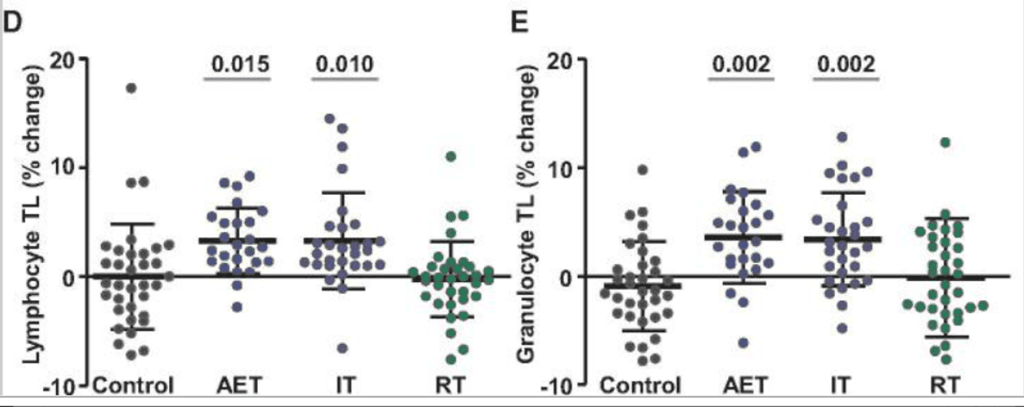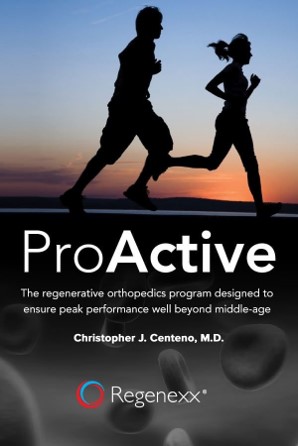How Do Various Types of Exercise Impact Your Telomeres? What the Heck Is a Telomere?

In finding your exercise groove, you have lots of options. That includes aerobic exercise, interval training, or lifting weights. Which one is best to counter aging? Let’s dig into a recent high-level study and also learn something about how your genes age.
Types of Exercise
One of the things you have to do, if you want to stay healthy, is to exercise often. The second thing you need to do is to make sure you keep your joints, tendons, ligaments, and spine healthy enough to be able to exercise, which is where Regenexx comes into play. Finally, you need to decide what type of exercise is best.
One of the things we know is that weight lifting can keep your muscles young. That’s critical for not only how you look, but also to fight off things like osteoporosis. However, what we don’t know is how the three different types of exercise impact your overall aging process.
What Are Telomeres?
Today we’ll review research on Telomeres. What are they and why should you care? You may remember from high school biology that your cells contain a manufacturing blueprint called genes or DNA. When your cells divide, each gets a copy of that DNA. However, Nature has installed a safety mechanism to make sure our cells can’t divide forever (which is what cancer cells can do). That’s called a Telomere.
Think of a Telomere as a genetic clock that lives on the end of a DNA strand. A little bit of that Telomere gets chipped off every time the DNA divides and get’s copied. Hence, as we get older, our Telomeres get shorter. It’s believed that this Telomere shortening also causes premature aging and that any viable anti-aging strategy should lengthen Telomeres or at least stop how quickly they get shortened.
The New Research on Telomeres and Types of Exercise
Researchers in Germany conducted a randomized controlled trial where 124 patients were assigned to a 6-month program of either aerobic endurance training, 4X4 interval training, and weight training (1). After all of this, blood samples were taken and the white blood cells were tested for Telomere length. This is what they found:

Credit: European Heart Journal
What are you looking at? This is the percentage change in Telomere length in two white blood cell types: lymphocytes and granulocytes. The control and weight lifting (RT) groups all cluster around the 0% change line, while the aerobic exercise training (AET) and interval training (IT) groups show a 2% or so increase in the length of the Telomere. How much gain of lifespan is that? By using what’s published and a little simple math, over a lifetime you lose about 30% of the Telomere length, so this could be an extra 5 years or so of life (2). Now that’s if the only thing that defined death was an exhausted telomere, which isn’t true. Meaning people die of all sorts of things like heart disease and cancer even with longer Telomeres. However, 2% Telomere lengthening over 6 months is nothing to sneeze at!
What Type of Exercise Specifically?
First, this was three times a week exercise. The aerobic exercise was 45 minutes of walking or running at 60% heart rate reserve (between 60-100 beats per minute for the average adult). So let’s say keeping your heart rate between 90-100.
4×4 interval training involves four periods of four-minute bursts of high-intensity exercise (where you are too out of breath to speak more than a few words) broken up by three-minute periods at a lower intensity (where you are too out of breath to sing but can speak a full sentence).
So What Should You Do?
Or better yet, how will this program change what I do? On the one hand, you can’t ignore the strong data for younger muscles due to heavy weight lifting and generally keeping a younger appearance as you age (including better bone density). On the other hand, Telomeres that are about 5 years younger are pretty great. Hence, I’ll thread the needle here. I’ll keep up with my two days a week of heavy weights and add in 3 days a week of either aerobic or 4×4 IT. Now I already have at least two 60-minute hikes uphill where I know I’m in the 90-100 beats per minute range. Hence, to that, I’ll add one or two 4X4 sessions.
What If I Hurt Too Much to Work Out?
That’s where we come in. When you’re young, you don’t think twice about doing any kind of exercise, it’s merely a matter of the inspiration or the will to do it. As we age, our old injuries begin to add up and it gets harder to start programs like this one.
If you’re an aging athlete, I’m right there with you, so about twice a year, I participate in our Regenexx ProActive program by having our doctors inject various areas I know are small problems. For example, my right knee MCL was getting lax and that joint has early arthritis, so I had Dr. Markle inject the MCL and joint with high-dose PRP. If you want to find out more about how we Regen Med doctors use orthobiologics to keep active as we age, read my book:
The upshot? If you can get about 5 years of Telomere length back, why wouldn’t you do it? Hence, keep your body going as you age because these exercise aging hacks usually involve you moving your body!
_____________________________________________
(1) Werner CM, Hecksteden A, Morsch A, Zundler J, Wegmann M, Kratzsch J, Thiery J, Hohl M, Bittenbring JT, Neumann F, Böhm M, Meyer T, Laufs U. Differential effects of endurance, interval, and resistance training on telomerase activity and telomere length in a randomized, controlled study. Eur Heart J. 2019 Jan 1;40(1):34-46. doi: 10.1093/eurheartj/ehy585. PMID: 30496493; PMCID: PMC6312574.
(2) Shammas MA. Telomeres, lifestyle, cancer, and aging. Curr Opin Clin Nutr Metab Care. 2011;14(1):28-34. doi:10.1097/MCO.0b013e32834121b1

NOTE: This blog post provides general information to help the reader better understand regenerative medicine, musculoskeletal health, and related subjects. All content provided in this blog, website, or any linked materials, including text, graphics, images, patient profiles, outcomes, and information, are not intended and should not be considered or used as a substitute for medical advice, diagnosis, or treatment. Please always consult with a professional and certified healthcare provider to discuss if a treatment is right for you.

